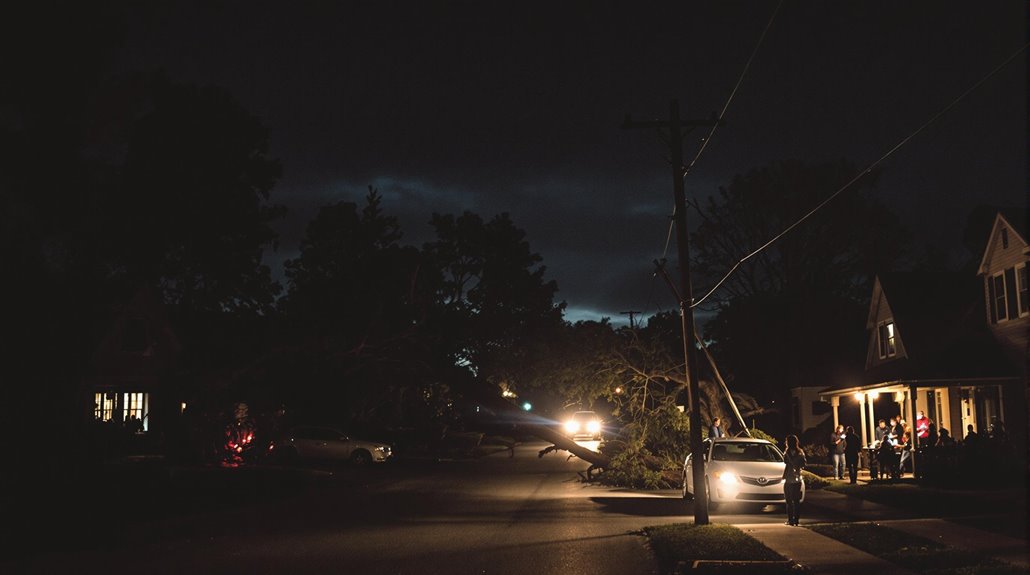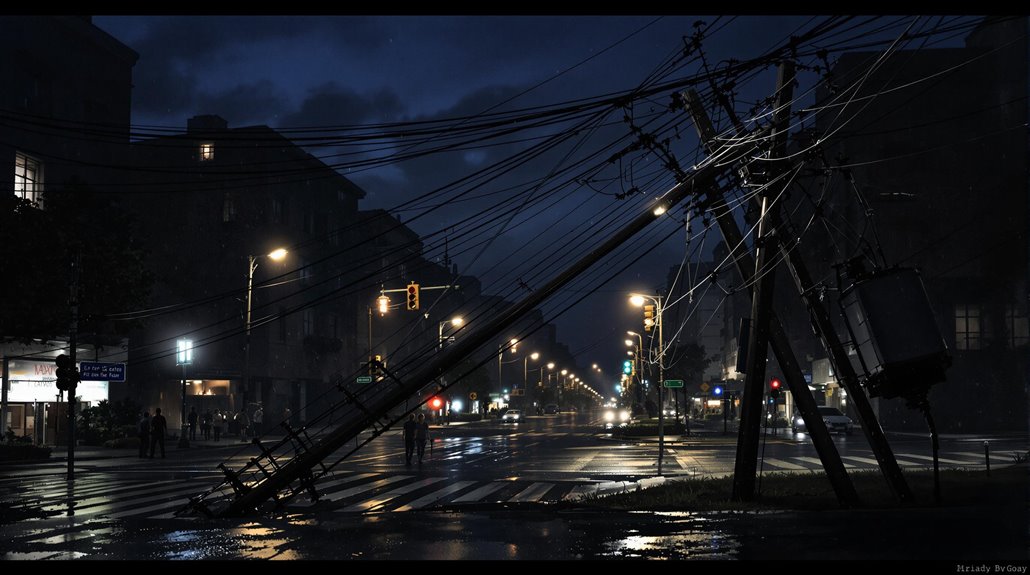What Is a Power Outage and What Causes Them?

A power outage occurs when your electrical service gets disrupted, ranging from a complete blackout to temporary voltage drops. You'll most commonly experience outages due to severe weather (83% of cases), falling trees, equipment failures, and even animal interference - with squirrels causing up to 30% of disruptions. These interruptions can last anywhere from moments to months, depending on the cause. Understanding the different types and causes can help you better prepare for future disruptions.
Understanding the Different Types of Power Outages
How can you tell what type of power outage you're experiencing? Power outages come in several forms, each affecting the electrical grid differently. A complete power blackout means a total loss of electricity in your area, often caused by severe weather or permanent fault in power systems. You'll notice voltage sags when your lights dim temporarily, typically due to heavy electrical demands on the power grid. Short circuits can trigger momentary interruptions, where you'll experience a sudden loss of power that quickly returns.
There are also brownouts, which reduce your electrical supply without completely cutting it off. The most severe are rolling blackouts, where utilities deliberately cycle different types of power interruptions through various areas to prevent grid collapse. Understanding these distinctions helps you better respond to and prepare for electrical emergencies. With aging infrastructure components averaging 40-50 years old, power outages are becoming increasingly common across the electrical grid.
Most Common Causes Behind Electrical Grid Failures
While power outages can occur for various reasons, severe weather remains the leading culprit behind electrical grid failures, causing 83% of all disruptions. Natural disasters like hurricanes, tornadoes, and ice storms can severely damage electrical infrastructure and transmission lines, leaving you without power for extended periods.
You'll find that falling trees and vegetation pose another significant threat to power lines, with wildlife - particularly squirrels - contributing to a substantial number of incidents. Equipment failure, including transformer malfunctions and wire damage, can also interrupt your electrical power supply. Vehicle accidents involving utility poles frequently cause localized outages in urban areas.
During extreme weather conditions, you might experience blackouts due to grid overload, especially when there's high demand from air conditioning use during heatwaves. The Arctic cold front that swept through Texas in 2021 left nearly 10 million residents without power and revealed critical vulnerabilities in the state's electrical infrastructure.
Duration and Impact on Communities

Power outages can range from brief inconveniences to catastrophic events lasting weeks or even months. When major weather events damage electrical equipment, transmission and distribution networks, or power stations, communities face severe disruptions to daily life. The 2003 Northeast blackout demonstrated how vulnerable our electrical power network can be, affecting over 50 million people when multiple utility poles and circuit breakers failed.
You'll find that extended outages impact every aspect of community life. When power goes down, you lose access to essential services as cell towers fail, businesses close, and critical infrastructure struggles to operate. Whether caused by severe storms or solar storms, prolonged blackouts can lead to significant economic losses through spoiled goods, business interruptions, and the need for backup power solutions. The recovery timeline depends on the extent of damage to power infrastructure. During the 1965 Northeast Blackout, 800,000 subway passengers were stranded underground when the power failed across multiple states and parts of Canada.
Preventive Measures and Safety Protocols
Taking preventive steps against power outages starts with understanding basic safety protocols and preparation measures. You'll want to stay informed about your power suppliers' scheduled maintenance in your service area and support their preventive maintenance efforts, including tree trimming around transmission lines.
To protect your equipment during severe weather conditions, install surge protectors and maintain a backup power source. You should also regularly check your home's electrical connections and report any issues to your utility company. Power suppliers work continuously to strengthen the electrical grid through infrastructure upgrades and safety protocols, but your cooperation is essential. Keep emergency contact numbers handy, follow official guidance during outages, and never approach downed power lines. Creating and maintaining an emergency kit with essential supplies will help you stay prepared. Solar power systems can provide reliable backup electricity during extended outages when paired with battery storage.
Reporting and Tracking System Disruptions

Effective reporting of system disruptions plays a key role in maintaining reliable electrical service. When you experience power outages, you'll need to contact your local transmission and distribution service provider (TDSP) to report the issue. Your utility companies rely on customer reporting to pinpoint problems and coordinate restoration efforts.
Modern outage tracking systems help identify patterns and causes of electrical grid failures. Intriguingly, animal interference accounts for over 1,000 power supply disruptions annually, with cybersquirrel operations documenting that squirrels cause up to 30% of these outages in certain regions. Birds and snakes are also frequent culprits. To streamline the reporting process, most utilities now offer multiple ways to report disruptions, including dedicated hotlines and online tools that let you monitor service restoration progress in real-time.




